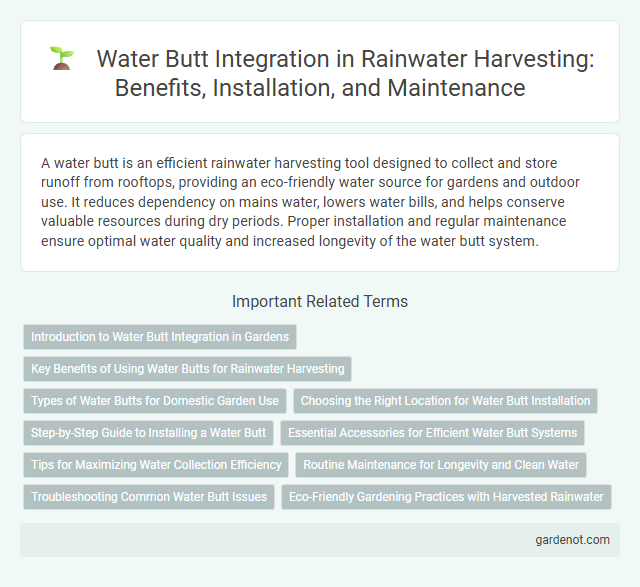A water butt is an efficient rainwater harvesting tool designed to collect and store runoff from rooftops, providing an eco-friendly water source for gardens and outdoor use. It reduces dependency on mains water, lowers water bills, and helps conserve valuable resources during dry periods. Proper installation and regular maintenance ensure optimal water quality and increased longevity of the water butt system.
Introduction to Water Butt Integration in Gardens
Water butts serve as an efficient rainwater harvesting solution, capturing runoff from garden rooftops to reduce mains water usage. Integrating a water butt into garden systems supports sustainable irrigation by storing valuable rainwater for watering plants, lawns, and vegetable beds during dry periods. This eco-friendly method promotes water conservation, lowers utility bills, and helps protect local water resources.
Key Benefits of Using Water Butts for Rainwater Harvesting
Water butts efficiently collect and store rainwater, reducing dependency on mains water and lowering utility bills. They help conserve water resources by providing a sustainable supply for garden irrigation, car washing, and other outdoor uses. Using water butts also minimizes stormwater runoff, decreasing soil erosion and reducing the risk of local flooding.
Types of Water Butts for Domestic Garden Use
Water butts for domestic garden use come in various types, including plastic, wooden, and metal models, each offering different benefits regarding durability and aesthetics. Plastic water butts are lightweight, affordable, and resistant to rust, while wooden water butts provide a natural appearance that blends well with garden landscapes. Metal water butts, typically made from galvanized steel or aluminum, offer robust construction and longevity but may require treatment to prevent corrosion and algae growth.
Choosing the Right Location for Water Butt Installation
Selecting the optimal location for water butt installation requires ensuring proximity to downpipes for efficient rainwater collection and stable, level ground to support the weight when full. Position the water butt near garden areas to facilitate easy access for watering plants while avoiding shaded spots that may promote algae growth. Proper placement also enables straightforward connection with overflow outlets to prevent flooding during heavy rainfall.
Step-by-Step Guide to Installing a Water Butt
Installing a water butt begins with selecting a suitable, level location near a downpipe to ensure efficient water collection. Attach the water butt diverter kit to the downpipe, cutting the pipe as needed to connect the spout and enable runoff redirection into the barrel. Secure the water butt on a sturdy base and install the tap at the bottom for easy water access, completing the setup for sustainable rainwater harvesting.
Essential Accessories for Efficient Water Butt Systems
Essential accessories for efficient water butt systems include a sturdy filter to remove debris, a diverter kit to channel rainwater from guttering, and a secure lid to prevent contamination and mosquito breeding. Installing a tap or hose connector enhances water accessibility for gardening or other household uses. A stand elevates the water butt, improving water flow and ease of use while protecting the container from ground moisture.
Tips for Maximizing Water Collection Efficiency
Position the water butt under a downpipe to capture maximum runoff from roofs, ensuring it is sealed with a fine mesh to prevent debris and mosquito breeding. Regularly clean gutters and the water butt to maintain unobstructed flow and water quality. Use a first-flush diverter to discard initial roof wash-off, improving the purity of collected rainwater for garden and household use.
Routine Maintenance for Longevity and Clean Water
Regularly cleaning the water butt and removing debris from the filter ensures efficient rainwater collection and prevents contamination. Inspecting seals and joints for leaks maintains system integrity, reducing water wastage and prolonging the lifespan of the water butt. Periodic flushing of the tank inhibits algae growth, preserving the quality of stored rainwater for safe gardening and household use.
Troubleshooting Common Water Butt Issues
Water butt troubleshooting often involves addressing clogs from leaves or debris in the inlet or overflow outlets, which can impede water flow and cause overflow problems. Inspecting and cleaning the water butt filter and downpipe regularly ensures efficient rainwater collection and prevents stagnation that leads to unpleasant odors. Leak detection in joints or taps requires sealing with waterproof tape or replacing faulty components to maintain water butt integrity and prevent water loss.
Eco-Friendly Gardening Practices with Harvested Rainwater
Water butts are essential tools in eco-friendly gardening, enabling the collection and storage of harvested rainwater for irrigation purposes. Using rainwater stored in water butts reduces reliance on mains water, lowers water bills, and minimizes environmental impact by conserving natural resources. This sustainable practice supports healthy plant growth with chemical-free water, promoting biodiversity and reducing runoff pollution.
Water butt Infographic

 gardenot.com
gardenot.com